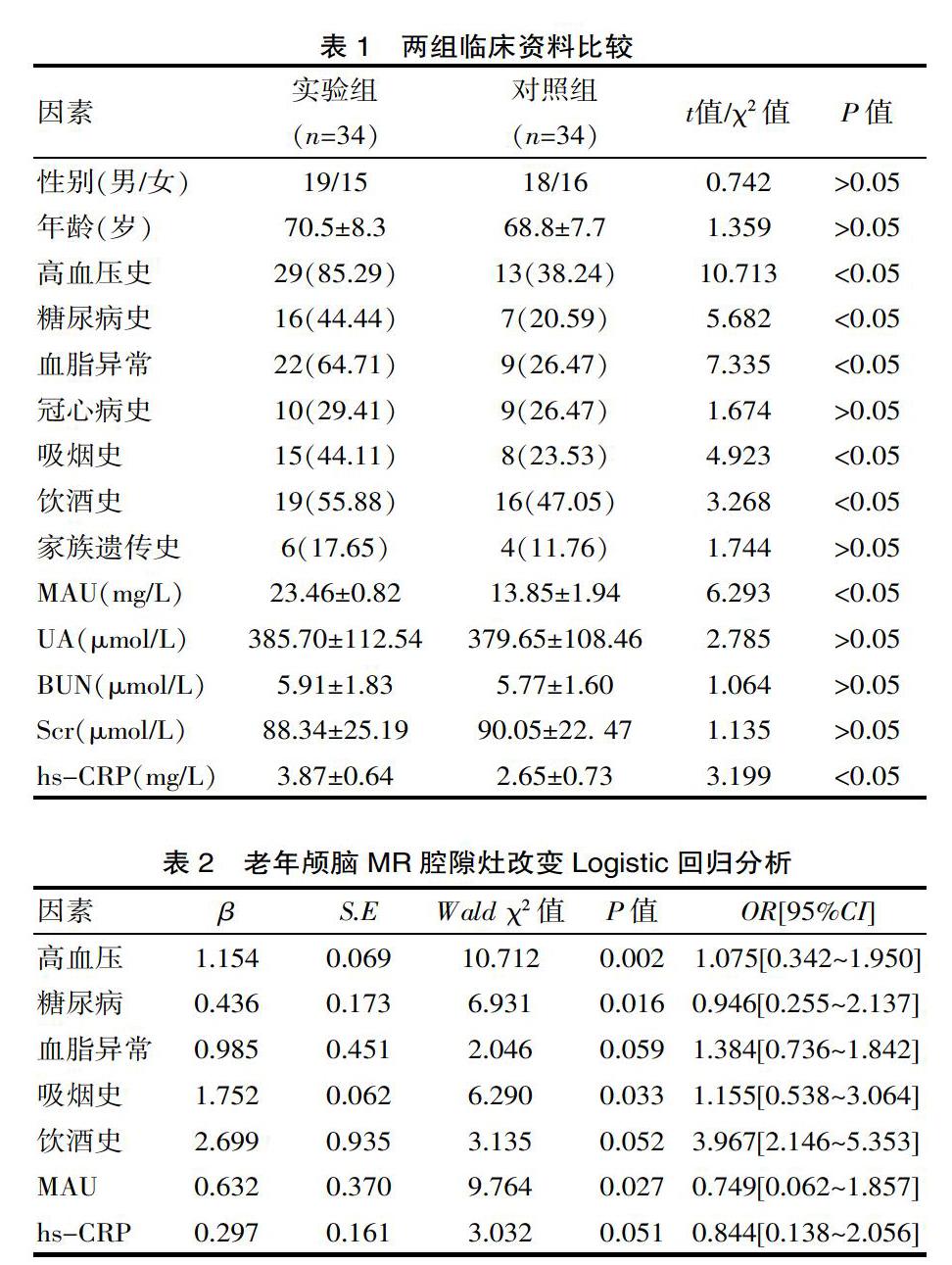老年颅脑腔隙灶改变危险因素及与尿微量白蛋的相关性
邱钦圣 许团新

[摘要] 目的 探讨老年颅脑腔隙灶改变的危險因素及与尿微量蛋白的相关性,为该病临床诊治提供依据参考。 方法 以2017年1月—2018年12月为时限,方便择取该院及东莞东华医院颅脑MR检查可见腔隙灶改变的34例老年患者为实验组,另择取该院及东莞东华医院同期34例颅脑MR示正常的老年健康志愿者为对照组,对比观察两组尿微量蛋白蛋水平,收集两组临床资料,Logistic回归分析导致老年颅脑MR腔隙灶改变的危险因素。结果 实验组高血压病史85.29%、糖尿病史44.44%,血脂异常64.71%,吸烟史44.11%,饮酒史55.88%,尿微量白蛋白(23.46±0.82)mg/L,均高于对照组(χ2=10.713,5.682,7.335,4.923,3.268,t=6.293;P<0.05),Logistic示是老年颅脑MR腔隙灶改变独立危险因素。结论 尿微量白蛋白水平升高是老年颅脑MR腔隙灶改变的独立危险因素,此外也受高血压、糖尿病与吸烟的影响,应引起临床重视,重点加强防治。
[关键词] 头颅MR;腔隙灶改变;尿微量白蛋白;危险因素
[中图分类号] R5 [文献标识码] A [文章编号] 1674-0742(2019)05(c)-0178-03
[Abstract] Objective To investigate the risk factors of cerebral ventricle changes in the elderly and its correlation with microalbuminuria, and provide evidence for clinical diagnosis and treatment of this disease. Methods From January 2017 to December 2018, 34 elderly patients with changes in luminal lesions in our hospital and Donghua Hospital of Dongguan were convenient chosen as experimental group. At the same time, 34 elderly healthy volunteers in Donghua Hospital with normal brain MR showed the control group. The urine microalbumin levels were compared between the two groups. The clinical data of the two groups were collected. Logistic regression analysis showed the risk factors of MR lesions in the elderly. Results The experimental group had a history of hypertension of 85.29%, a history of diabetes of 44.44%, a dyslipidemia of 64.71%, a history of smoking of 44.11%, a drinking history of 55.88%, and a urine microalbumin (23.46±0.82) mg/L, which were higher than the control group (χ2=10.713,5.682,7.335,4.923,3.268,t=6.293; P<0.05), Logistic showed an independent risk factor for MR luminal changes in elderly patients. Conclusion The increase of urinary microalbumin is an independent risk factor for the changes of MR lesions in elderly patients. In addition, it is also affected by hypertension, diabetes and smoking. It should be given clinical attention and focus on strengthening prevention and treatment.
[Key words] Skull MR; Luminal lesion changes; Urine microalbumin; Risk factors
腔隙性脑梗死指脑实质内小穿支动脉病理改变引起管腔闭塞所导致的缺血性小梗死灶,由于坏死、液化的脑组织由吞噬细胞移走形成空腔而得名,是临床常见脑血管疾病,数据统计约占全部脑梗死的25%[1]。该病累及范围小,以多发性数毫米囊性病灶为主要病理改变,病因病机复杂,包括血管内皮功能障碍损伤过程,其局灶性神经症状与体征较轻,甚至无症状,颅脑MR可见脑部腔隙性病灶改变,是临床诊断本病的重要标准[2]。尿微量白蛋白(MAU)能够反映肾损伤情况,既往主要用于肾脏疾病早期诊断。近年有研究指出,MAU在全身性血管内皮功能紊乱与血管通透性增加中也有表达[3],因此,其与腔隙性脑梗死的发生与进展是否存在相关性,值得研究与探讨。文章现以2017年1月—2018年12月该院及东莞东华医院收治34患者为例,分析探讨老年颅脑MR腔隙灶危险因素及与MAU相关性,报道如下。

